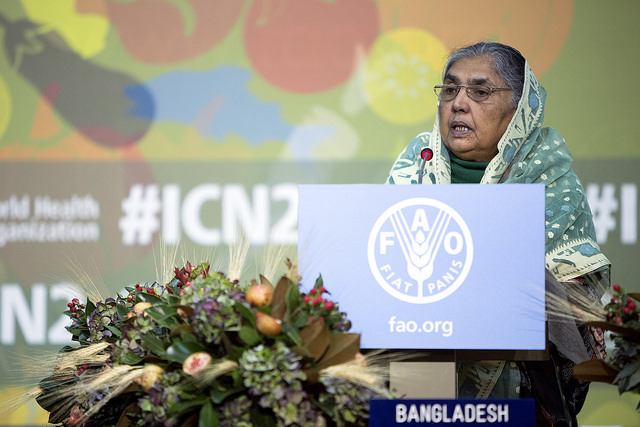The recently concluded Second International Conference on Nutrition (ICN2) in Rome, Italy, identified nutrition-sensitive agriculture as one of the priorities in the quest to end global hunger and malnutrition by 2025.
Delegates, including high-level representatives from Bangladesh, Malawi, Nigeria, Pakistan, and Uganda highlighted biofortification among strategies to achieve that goal. Scaling up access to biofortified nutritious foods for more people globally has become a major objective of governments and organizations following the Second Global Conference on Biofortification in Kigali, Rwanda, earlier this year.
A number of countries have already identified biofortification as a key component of their nutrition strategies, and others are taking the lead in developing biofortified crops. These crops are conventionally bred to be rich in micronutrients such as vitamin A, iron, and zinc.
More than 2 billion people globally still lack one or more of these essential micronutrients in their diets, increasing their risk of physical and cognitive impairment, and susceptibility to infectious diseases. Bangladesh, for example, has released the country’s first zinc-biofortified rice variety, and orange sweet potato has been developed and locally adapted by the International Potato Center, Bangladeshi Minister of Agriculture Matia Chowdhury revealed to ICN2 delegates. Both the leaves and the roots of orange sweet potato provide vitamin A, which is good for the eyes and helps the body fight disease, she noted.
In Pakistan, the Government supports biofortified high-zinc wheat, said Rizwan Bashir Khan, Leader of the Pakistan delegation.
Many African countries, including Nigeria, have released biofortified nutritious crops to farmers. “Biofortification must be vigorously supported within the broader context of promoting a diversified and healthy food base for improved nutrition,” urged Dr. Akinwumi Adesina, Nigeria’s Minister of Agriculture and Rural Development in his remarks at the conference.
Noting that Nigeria has “taken a lead on policies for biofortification in Africa”, Dr. Adesina estimated that 80 million Nigerians will have access to biofortified vitamin A cassava over the next four years. Countries like Uganda, which have adopted biofortified crops, see expanding access to these crops as critical to addressing malnutrition.
“Some agencies are promoting biofortified foods like beans, maize, rice, millet and orange sweet potatoes rich in micronutrients, but this is not on a large scale,” Uganda’s Minister of State for Health, Sarah Achieng Opendi, told ICN2 participants. “We need to embrace such tested and approved technologies and scale them up in our countries if we are to avert the issues of malnutrition, especially hidden hunger.”
Also expressing support for biofortification was the Global Panel on Agriculture and Food Systems for Nutrition, which launched its first technical brief at ICN2. The brief calls for agricultural policies that encourage “plant breeding research that improves the levels of nutrients in cereals and other staple crops, often called biofortification.”
ICN2, which brought together representatives from more than 170 governments as well as from civil society and business culminated in the Rome Declaration on Nutrition and the Framework for Action. These conference outcomes commit world leaders to establish national policies aimed at eradicating malnutrition and transforming food systems to make nutritious diets available to all.
